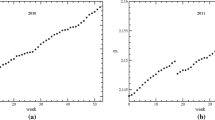Abstract
The possibility of using the statistics of recurrence time for extreme events is studied in this paper having in mind the problems of control and prediction of failures in spacecraft operation. The information about failures onboard satellites of various types presented by the US National Geophysical Data Center was analyzed. It was found that the probability density of recurrence intervals followed a power law of the Pareto type with an index equal to 2.3. The obtained result is consistent both with the theory of normal catastrophes and with the principle of self-organization of criticality for metastable active heterogeneous environment. A practical consequence of the obtained result consists in the fact that predictions of these extreme events should not rely on traditional models with the second-order Pearson statistics. To make predictions, the models are necessary that take into account the power law distribution of recurrence intervals for failures on satellites. The failures should be considered in these models as extreme events connected with manifestation of the space environment factors.
Similar content being viewed by others
References
Iucci, N., Levitin A. E., Belov A.V., et al., Space Weather Conditions and Spacecraft Anomalies in Different Orbits, Space Weather, 2005, vol. 3, p. 01001. doi: 10.1029/2003SW000056.
Baker, D.N., Allen, J.K., Kanekal, S.G., et al., Disturbed Space Environment May Have Been Related to Pager Satellite Failure, EOS Trans. AGU, 1998, vol. 79, p. 477.
Panasyuk, M.I., The Trapped Anomalous Component of the Cosmic Rays: the Short Overview of Experiments, Inter. J. Modern Phys., 2002, vol. 17A, p. 1705.
Pilipenko, V.A., Romanova, K.V., and Chizhenkov, V.A., Effect of Space Weather on Satellite Systems, Izv. Mosk. Gos. Univ., Sek. Nauk o Zemle, 2006, no. 14, p. 93.
Allan, J., Sauer, H., Frank, I., and Reiff, P., Effects of the March 1989 Solar Activity, EOS, 1989, vol. 70, p. 1479.
Adams, J.H., Beliaev, A.A., Kuznetsov, N.V., et al., Occurrence Frequency of Single-Event Upsets Inducted on Synchronous Orbit: Model Calculations and TDRS-1 Experiment, Radiat. Meas., 1996, vol. 22, p. 509.
Brautigam, D.H., CRRES in Review: Space Weather and Its Effect on Technology, J. Atmos. Sol.-Terr. Phys., 2002, vol. 64, p. 1709.
Cole, D.G., Space Weather: Its Effects and Predictability, Space Science Reviews, 2003, vol. 107, nos. (1–2), p. 295.
Schwenn, R., Space Weather: The Solar Perspective, Living Reviews in Solar Physics, 2006, vol. 3.
Pulkkinen, T., Space Weather: Terrestrial Perspective, Living Reviews in Solar Physics, 2007, vol. 4.
Leadbetter, M.R., Lindgren, G., Rootzen, H., Extremes and Related Properties of Random Sequences and Processes, New York: Springer, 1983. Translated under the title Ekstremumy sluchainykh posledovatel’nostei i protsessov, Moscow: Mir, 1989.
Albeverio, S. and Piterbarg, V., Mathematical Methods and Concepts for the Analysis of Extreme Events, in Extreme Events in Nature and Society, Berlin-Heidelberg: Springer, 2006, pp. 47–68.
Newman, M.E.J., Power Laws, Pareto Distributions, and Zipf’s Law, Contemporary Physics, 2005, vol. 46, p. 323.
Malinetskii, G.G. and Potapov, A.B., Sovremennye problemy nelineinoi dinamiki (Modern Problems of Nonlinear Dynamics), Moscow: URSS, 2002.
Mandelbrot, B., Fractals and Scaling in Finance: Discontinuity, Concentration, Risk, New York: Springer, 1997. Translated under the title Fraktaly, sluchai i finansy, Moscow-Izhevsk, 2003.
Wornell, G., Signal Processing with Fractals: A Wavelet-Based Approach, Prentice Hall Signal Processing Series, 1995.
Mitzenmacher, M., A Brief History of Generative Models for Power Law and Lognormal Distributions, Internet Mathematics, 2004, vol. 1, p. 226.
Clauset, A., Shalizi, C.R., and Newman, M.E.J., Power-Law Distributions in Empirical Data, SIAM Review, 2009. arXiv: 0706.1062.
Sornette, D. and Sornette, A., General Theory of the Modified Gutenberg-Richter Law for Large Seismic Moments, Bull. Seismol. Soc. of America, 1999, vol. 89, p. 1121.
Eichner, J.F. and Koscielny-Bunde, E., Bunde, A., et al., Power-Law Persistence and Trends in the Atmosphere: A Detailed Study of Long Temperature Records, Phys. Rev. E, 2003, vol. 68.
Balasis, G., Daglis, I., Kapiris, P., et al., From Pre-Storm Activity to Magnetic Storms: A Transition Described in Terms of Fractal Dynamics, Ann. Geophys., 2006, vol. 24, pp. 3557–3567.
Yung-Ping, Chou, What Affects the Power-Law Distribution of the X-Ray Solar Flares? A Theoretical Study Based on a Model of Uniform Normal Field, Astrophys. J., 1999, vol. 527, p. 958.
Boffetta, G., Carbone, V., Giuliani, P., et al., A Power Laws in Solar Flares: Self-Organized Criticality or Turbulence?, Phys. Rev. Lett., 1999, vol. 83, p. 4662.
Altman, E., Silva, E., and Caldas, I., Recurrence Time Statistics for Finite Size Intervals, Chaos, 2004, vol. 14, p. 975.
Altmann, K. and Kantz, H., Recurrence Time Analysis, Long-Term Correlations, and Extreme Events, Phys. Rev. E, 2005, vol. 71.
Kac, M., Probability and Related Topics in Physical Sciences, London: Interscience, 1959. Translated under the title Veroyatnost’ i smezhnye voprosy v fizike, Moscow: Mir, 1965.
Nicolis, C., Atmospheric Analogs and Recurrence Time Statistics: Toward a Dynamical Formulation, J. Atmosperic Sciences, 1998, vol. 55, p. 465.
Wilkinson, D.C., NOAA’s Spacecraft Anomaly Database and Examples of Solar Activity Affecting Spacecraft, J. Spacecraft, 1991, vol. 31, p. 160.
Goldstein, M.L., Morris, S.A., and Yen, G.G., Problems with Fitting to the Power-Law Distribution, The European Physical Journal B: Condensed Matter, 2004, vol. 41, no. 2, pp. 255–258.
Corral, A., Renormalization-Group Transformations and Correlations of Seismicity, Phys. Rev. Lett., 2005, vol. 95.
Saichev, A. and Sornetto, D., Universal Distribution of Interearthquake Times Explained, Phys. Rev. Lett., 2006, vol. 97.
Author information
Authors and Affiliations
Additional information
Original Russian Text © L.M. Karimova, O.A. Kruglun, N.G. Makarenko, N.V. Romanova, 2011, published in Kosmicheskie Issledovaniya, 2011, Vol. 49, No. 5, pp. 470–475.
Rights and permissions
About this article
Cite this article
Karimova, L.M., Kruglun, O.A., Makarenko, N.G. et al. Power law distribution in statistics of failures in operation of spacecraft onboard equipment. Cosmic Res 49, 458–463 (2011). https://doi.org/10.1134/S0010952511040058
Received:
Published:
Issue Date:
DOI: https://doi.org/10.1134/S0010952511040058




